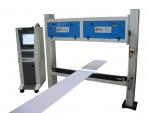Flexible films have been important for some time in the wine industries, most notably in the packaging of boxed product, as a functionalised multi-layer bladder to contain, and maintain the quality of, the wine.
Rheology of packaging materials:
The efficiency of many packaging processes, like flow-wrapping with flexible packaging or high-speed filling and sealing of flexible packaging can be influenced by many parameters. Foremost amongst these is the molecular architecture of the polymer(s) used in the packaging material. This may be even more critical for recycled or reprocessed materials. Furthermore, matching flow properties (in particular the viscosities) for adjacent polymers in multi-layered structures, such as those containing functional (e.g. gas or moisture barrier) and/or tie-layers is a critical first parameter for maintaining inter-layer compatibility, film clarity and functionality. These flow properties dictate the flow behaviour (rheology) of polymers and may be quantified by measuring the rheological parameters of the polymeric materials.
QC/QA with small scale process equipment:
The processing and packaging performance of the polymeric packaging materials may be tested on a laboratory scale using instrumented laboratory extrusion assets, with small-scale post-ex assets (like small scale cast film dies, blown-film towers, or injection moulders). In this way properly graded packaging base ingredients can be released for full-scale processing, and quality assurance/fault-tracing is facilitated during pre- or post-processing. Some laboratory
extruders may also be fitted with rheology dies, to measure rheological parameters, as well as service the scaled-down post-ex plant.
QC/QA with optical monitoring:
Even with a rheologically well defined base material, random impurities can enter the production process, and compromise the quality of the final product – by causing blemishes, holes and irregularities – in particular (but not only) for metalized films, light-coloured or small-gauge packaging.
During the manufacture of flexible or rigid packaging, optical methods can prove an invaluable technique for improving the final quality of these packaging materials. At the source (the polymer resin) optical scanning techniques can detect, qualify and quantify impurities, such as black-spots, before the resin is processed. Post-ex, scanning techniques can detect, quantify, qualify impurities (e.g. black spots, holes, fish-eyes) and therefore accurately grade product, indicating the likelihood of failure (tearing during packaging, sealing failure, holes or weak spots in metalized films) during packaging operations later.
Rheology Solutions offers a range of Equipment and Technical Literature tailored to Packaging and Polymer applications and industries.

